Deakin University MAA725: Advanced Accounting Debt Covenants Report
VerifiedAdded on 2022/09/07
|6
|1112
|208
Report
AI Summary
This report delves into the concept of debt covenants, which are crucial agreements between companies and lenders, designed to protect lender interests by restricting borrower activities. It categorizes covenants into financial and operational types, emphasizing their role in reducing borrowing costs and mitigating risks. The report then connects debt covenants to positive accounting theory (PAT), exploring how management choices of accounting policies are influenced by bonus plans, political costs, and the need to adhere to debt covenants. The report highlights the opportunistic and efficient forms of PAT, and how managers use accounting policies to manage reported earnings. The report also references several academic papers to support its claims and provides a comprehensive overview of the topic, including the hypotheses that underpin PAT and the implications of debt covenants on accounting practices.
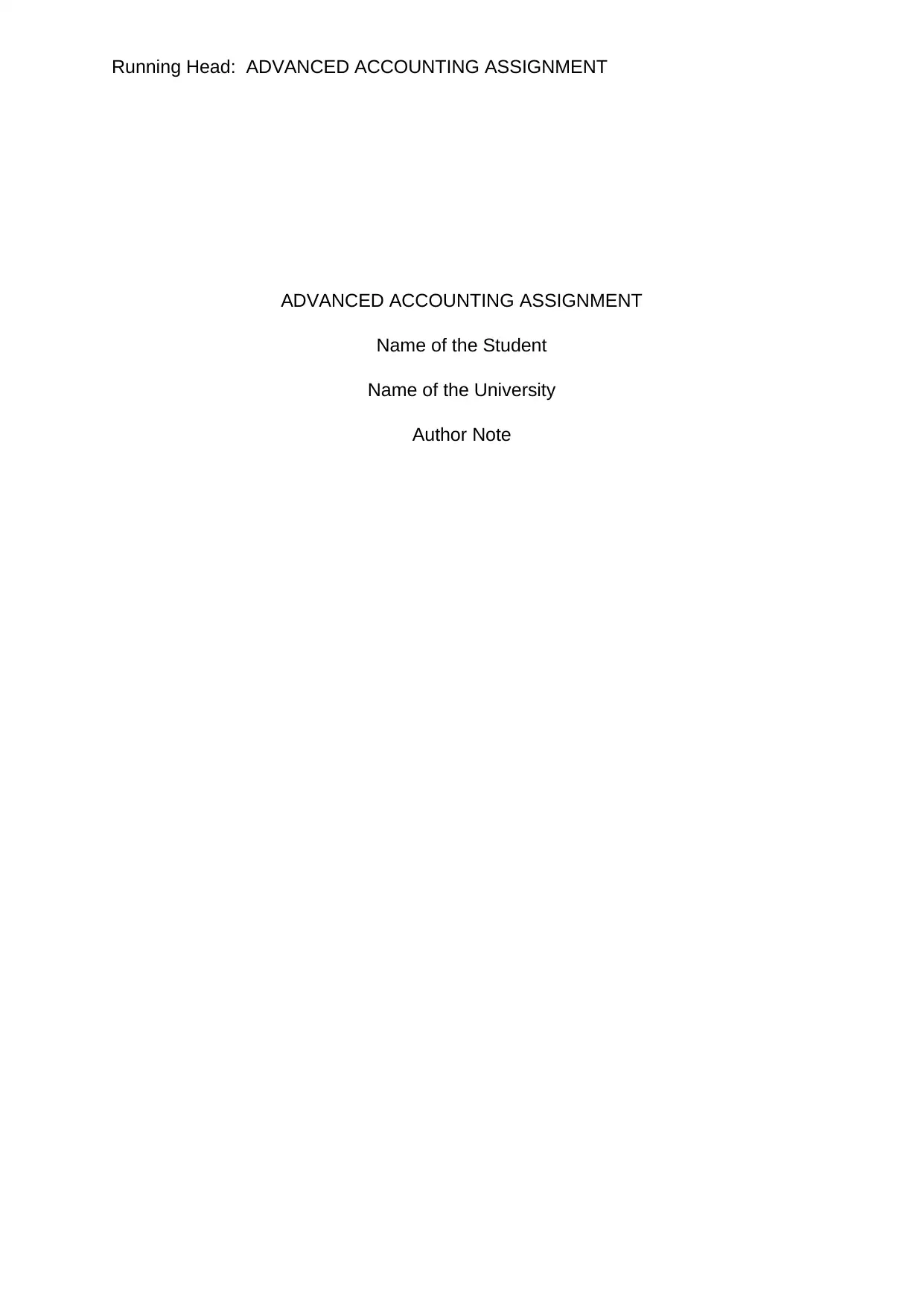
Running Head: ADVANCED ACCOUNTING ASSIGNMENT
ADVANCED ACCOUNTING ASSIGNMENT
Name of the Student
Name of the University
Author Note
ADVANCED ACCOUNTING ASSIGNMENT
Name of the Student
Name of the University
Author Note
Paraphrase This Document
Need a fresh take? Get an instant paraphrase of this document with our AI Paraphraser
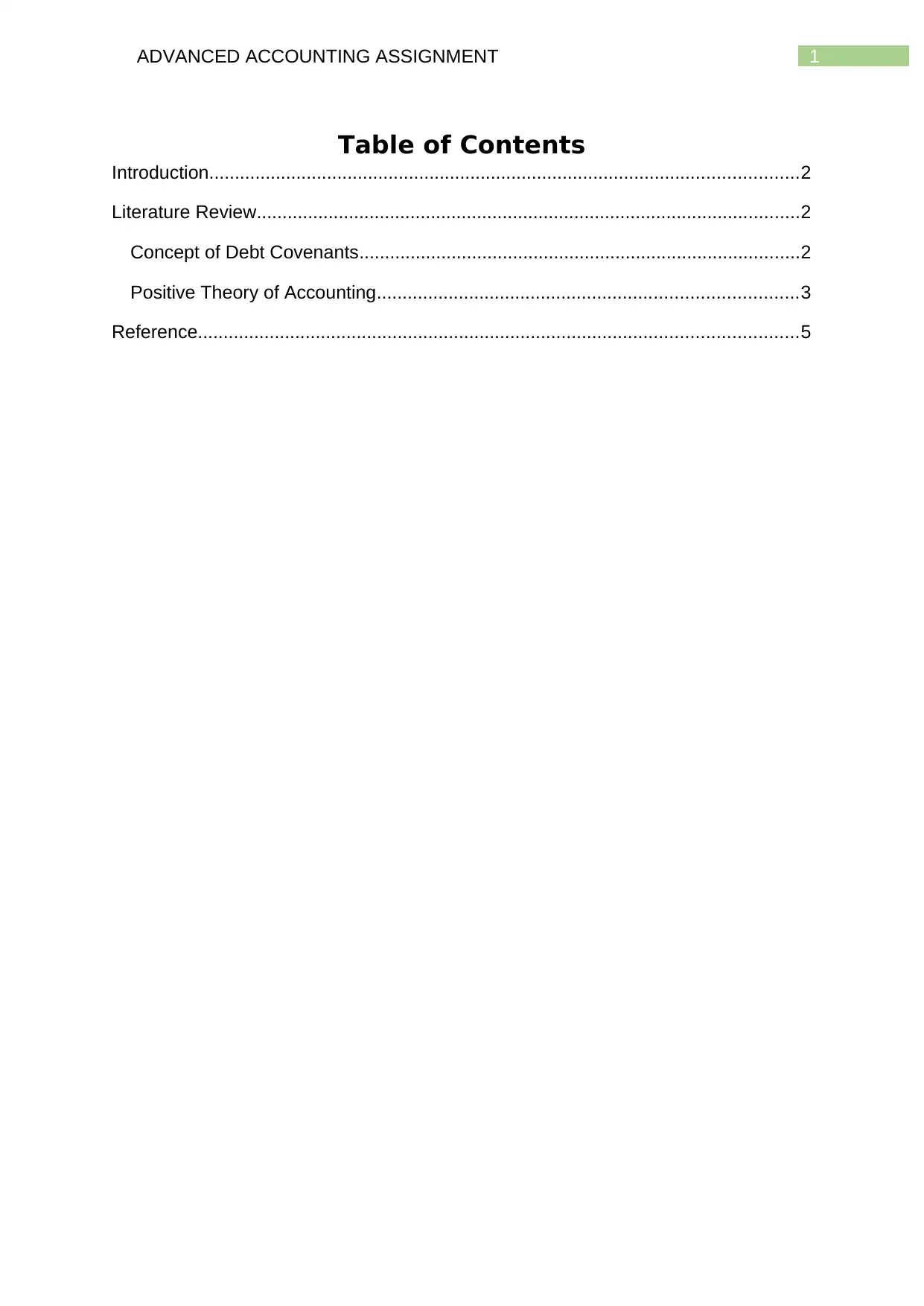
1ADVANCED ACCOUNTING ASSIGNMENT
Table of Contents
Introduction...................................................................................................................2
Literature Review..........................................................................................................2
Concept of Debt Covenants......................................................................................2
Positive Theory of Accounting..................................................................................3
Reference.....................................................................................................................5
Table of Contents
Introduction...................................................................................................................2
Literature Review..........................................................................................................2
Concept of Debt Covenants......................................................................................2
Positive Theory of Accounting..................................................................................3
Reference.....................................................................................................................5
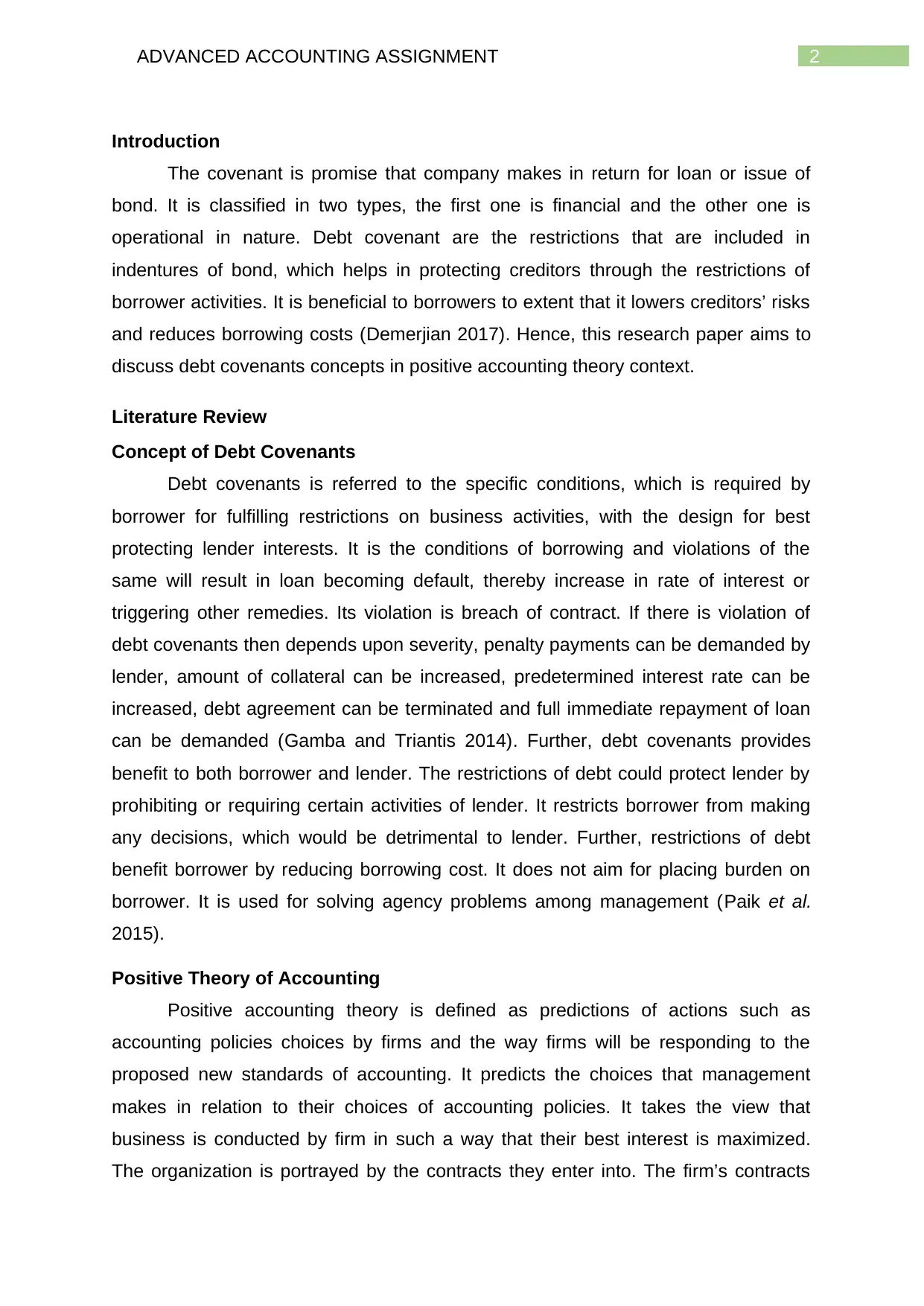
2ADVANCED ACCOUNTING ASSIGNMENT
Introduction
The covenant is promise that company makes in return for loan or issue of
bond. It is classified in two types, the first one is financial and the other one is
operational in nature. Debt covenant are the restrictions that are included in
indentures of bond, which helps in protecting creditors through the restrictions of
borrower activities. It is beneficial to borrowers to extent that it lowers creditors’ risks
and reduces borrowing costs (Demerjian 2017). Hence, this research paper aims to
discuss debt covenants concepts in positive accounting theory context.
Literature Review
Concept of Debt Covenants
Debt covenants is referred to the specific conditions, which is required by
borrower for fulfilling restrictions on business activities, with the design for best
protecting lender interests. It is the conditions of borrowing and violations of the
same will result in loan becoming default, thereby increase in rate of interest or
triggering other remedies. Its violation is breach of contract. If there is violation of
debt covenants then depends upon severity, penalty payments can be demanded by
lender, amount of collateral can be increased, predetermined interest rate can be
increased, debt agreement can be terminated and full immediate repayment of loan
can be demanded (Gamba and Triantis 2014). Further, debt covenants provides
benefit to both borrower and lender. The restrictions of debt could protect lender by
prohibiting or requiring certain activities of lender. It restricts borrower from making
any decisions, which would be detrimental to lender. Further, restrictions of debt
benefit borrower by reducing borrowing cost. It does not aim for placing burden on
borrower. It is used for solving agency problems among management (Paik et al.
2015).
Positive Theory of Accounting
Positive accounting theory is defined as predictions of actions such as
accounting policies choices by firms and the way firms will be responding to the
proposed new standards of accounting. It predicts the choices that management
makes in relation to their choices of accounting policies. It takes the view that
business is conducted by firm in such a way that their best interest is maximized.
The organization is portrayed by the contracts they enter into. The firm’s contracts
Introduction
The covenant is promise that company makes in return for loan or issue of
bond. It is classified in two types, the first one is financial and the other one is
operational in nature. Debt covenant are the restrictions that are included in
indentures of bond, which helps in protecting creditors through the restrictions of
borrower activities. It is beneficial to borrowers to extent that it lowers creditors’ risks
and reduces borrowing costs (Demerjian 2017). Hence, this research paper aims to
discuss debt covenants concepts in positive accounting theory context.
Literature Review
Concept of Debt Covenants
Debt covenants is referred to the specific conditions, which is required by
borrower for fulfilling restrictions on business activities, with the design for best
protecting lender interests. It is the conditions of borrowing and violations of the
same will result in loan becoming default, thereby increase in rate of interest or
triggering other remedies. Its violation is breach of contract. If there is violation of
debt covenants then depends upon severity, penalty payments can be demanded by
lender, amount of collateral can be increased, predetermined interest rate can be
increased, debt agreement can be terminated and full immediate repayment of loan
can be demanded (Gamba and Triantis 2014). Further, debt covenants provides
benefit to both borrower and lender. The restrictions of debt could protect lender by
prohibiting or requiring certain activities of lender. It restricts borrower from making
any decisions, which would be detrimental to lender. Further, restrictions of debt
benefit borrower by reducing borrowing cost. It does not aim for placing burden on
borrower. It is used for solving agency problems among management (Paik et al.
2015).
Positive Theory of Accounting
Positive accounting theory is defined as predictions of actions such as
accounting policies choices by firms and the way firms will be responding to the
proposed new standards of accounting. It predicts the choices that management
makes in relation to their choices of accounting policies. It takes the view that
business is conducted by firm in such a way that their best interest is maximized.
The organization is portrayed by the contracts they enter into. The firm’s contracts
⊘ This is a preview!⊘
Do you want full access?
Subscribe today to unlock all pages.

Trusted by 1+ million students worldwide
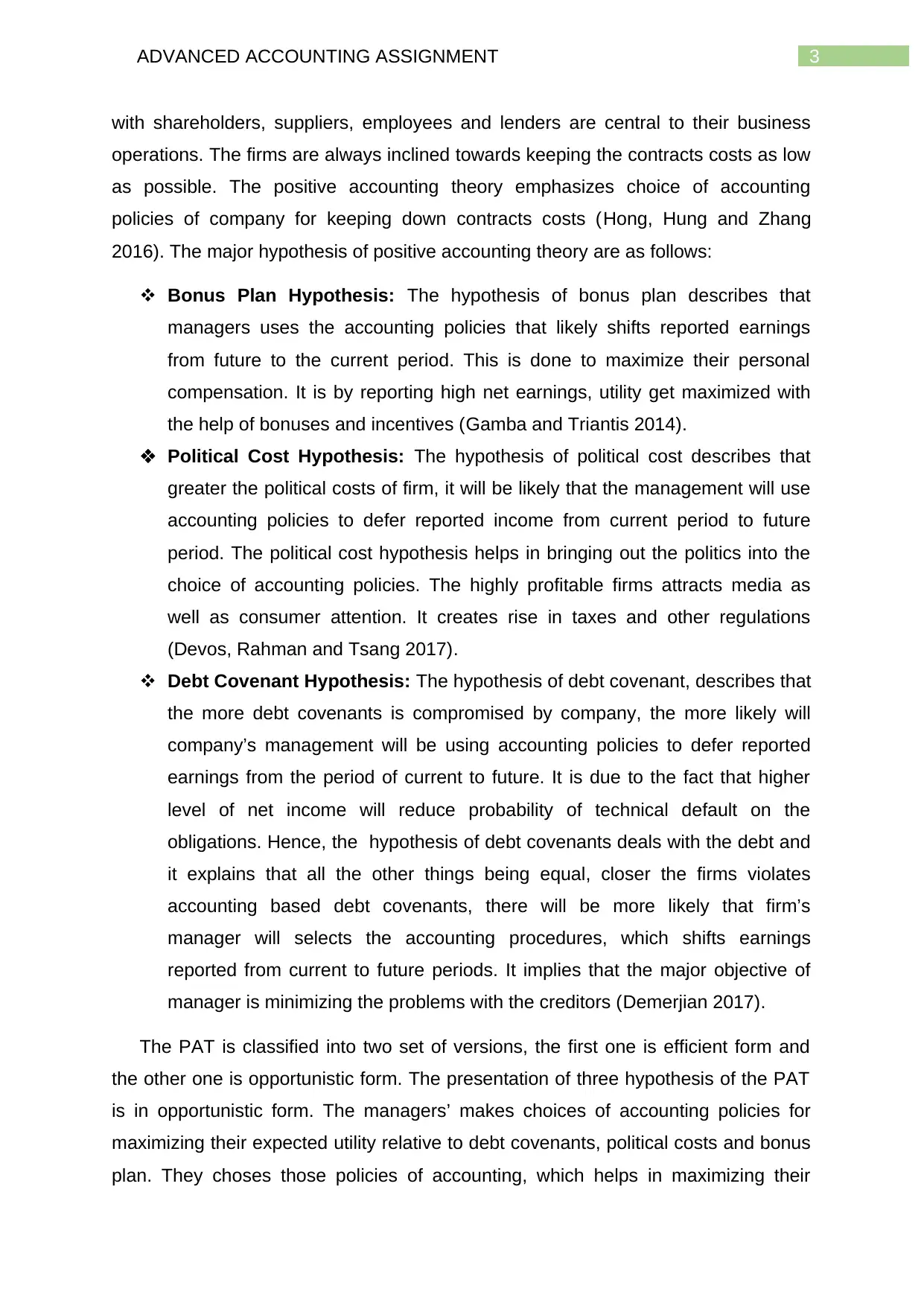
3ADVANCED ACCOUNTING ASSIGNMENT
with shareholders, suppliers, employees and lenders are central to their business
operations. The firms are always inclined towards keeping the contracts costs as low
as possible. The positive accounting theory emphasizes choice of accounting
policies of company for keeping down contracts costs (Hong, Hung and Zhang
2016). The major hypothesis of positive accounting theory are as follows:
Bonus Plan Hypothesis: The hypothesis of bonus plan describes that
managers uses the accounting policies that likely shifts reported earnings
from future to the current period. This is done to maximize their personal
compensation. It is by reporting high net earnings, utility get maximized with
the help of bonuses and incentives (Gamba and Triantis 2014).
Political Cost Hypothesis: The hypothesis of political cost describes that
greater the political costs of firm, it will be likely that the management will use
accounting policies to defer reported income from current period to future
period. The political cost hypothesis helps in bringing out the politics into the
choice of accounting policies. The highly profitable firms attracts media as
well as consumer attention. It creates rise in taxes and other regulations
(Devos, Rahman and Tsang 2017).
Debt Covenant Hypothesis: The hypothesis of debt covenant, describes that
the more debt covenants is compromised by company, the more likely will
company’s management will be using accounting policies to defer reported
earnings from the period of current to future. It is due to the fact that higher
level of net income will reduce probability of technical default on the
obligations. Hence, the hypothesis of debt covenants deals with the debt and
it explains that all the other things being equal, closer the firms violates
accounting based debt covenants, there will be more likely that firm’s
manager will selects the accounting procedures, which shifts earnings
reported from current to future periods. It implies that the major objective of
manager is minimizing the problems with the creditors (Demerjian 2017).
The PAT is classified into two set of versions, the first one is efficient form and
the other one is opportunistic form. The presentation of three hypothesis of the PAT
is in opportunistic form. The managers’ makes choices of accounting policies for
maximizing their expected utility relative to debt covenants, political costs and bonus
plan. They choses those policies of accounting, which helps in maximizing their
with shareholders, suppliers, employees and lenders are central to their business
operations. The firms are always inclined towards keeping the contracts costs as low
as possible. The positive accounting theory emphasizes choice of accounting
policies of company for keeping down contracts costs (Hong, Hung and Zhang
2016). The major hypothesis of positive accounting theory are as follows:
Bonus Plan Hypothesis: The hypothesis of bonus plan describes that
managers uses the accounting policies that likely shifts reported earnings
from future to the current period. This is done to maximize their personal
compensation. It is by reporting high net earnings, utility get maximized with
the help of bonuses and incentives (Gamba and Triantis 2014).
Political Cost Hypothesis: The hypothesis of political cost describes that
greater the political costs of firm, it will be likely that the management will use
accounting policies to defer reported income from current period to future
period. The political cost hypothesis helps in bringing out the politics into the
choice of accounting policies. The highly profitable firms attracts media as
well as consumer attention. It creates rise in taxes and other regulations
(Devos, Rahman and Tsang 2017).
Debt Covenant Hypothesis: The hypothesis of debt covenant, describes that
the more debt covenants is compromised by company, the more likely will
company’s management will be using accounting policies to defer reported
earnings from the period of current to future. It is due to the fact that higher
level of net income will reduce probability of technical default on the
obligations. Hence, the hypothesis of debt covenants deals with the debt and
it explains that all the other things being equal, closer the firms violates
accounting based debt covenants, there will be more likely that firm’s
manager will selects the accounting procedures, which shifts earnings
reported from current to future periods. It implies that the major objective of
manager is minimizing the problems with the creditors (Demerjian 2017).
The PAT is classified into two set of versions, the first one is efficient form and
the other one is opportunistic form. The presentation of three hypothesis of the PAT
is in opportunistic form. The managers’ makes choices of accounting policies for
maximizing their expected utility relative to debt covenants, political costs and bonus
plan. They choses those policies of accounting, which helps in maximizing their
Paraphrase This Document
Need a fresh take? Get an instant paraphrase of this document with our AI Paraphraser
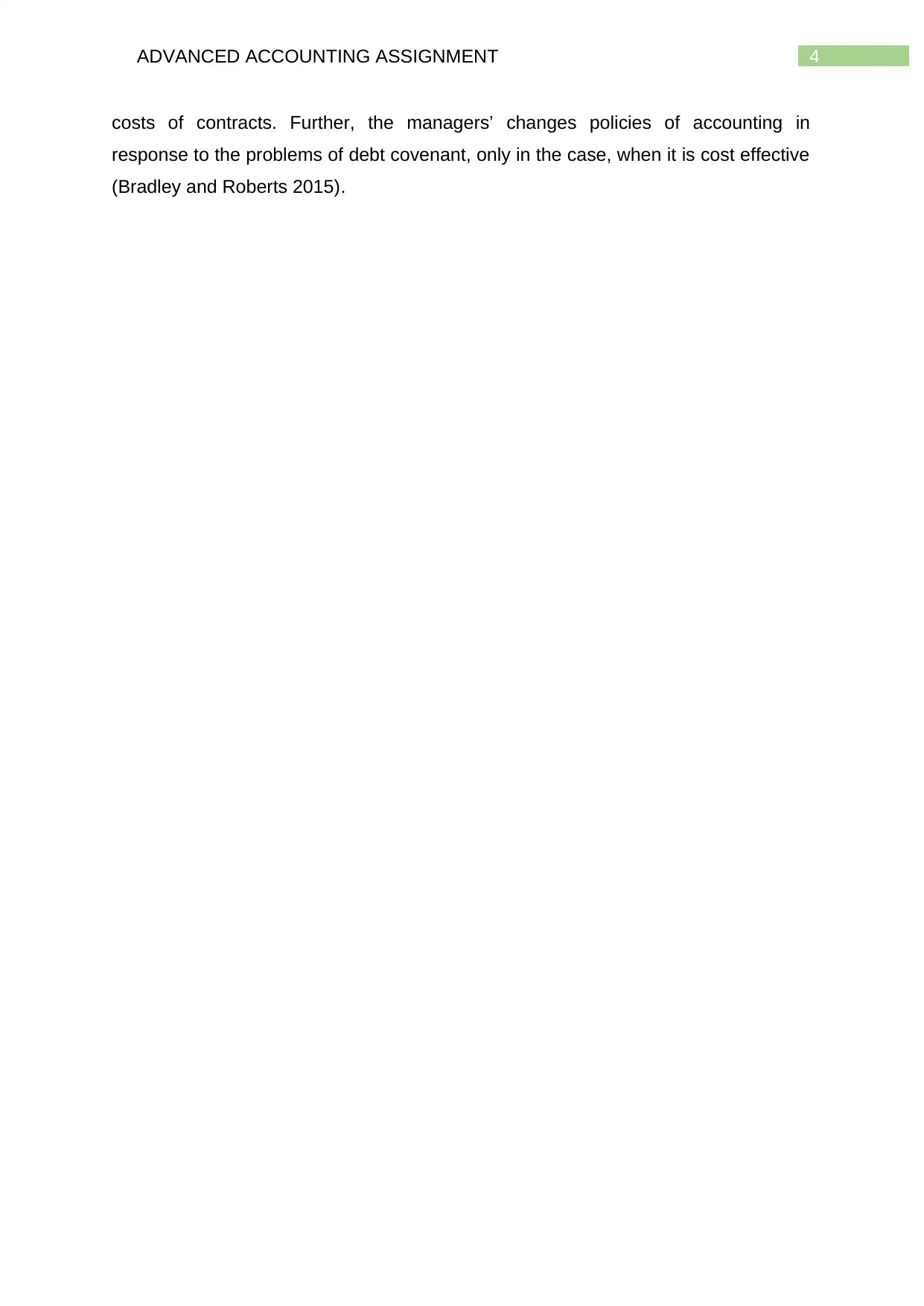
4ADVANCED ACCOUNTING ASSIGNMENT
costs of contracts. Further, the managers’ changes policies of accounting in
response to the problems of debt covenant, only in the case, when it is cost effective
(Bradley and Roberts 2015).
costs of contracts. Further, the managers’ changes policies of accounting in
response to the problems of debt covenant, only in the case, when it is cost effective
(Bradley and Roberts 2015).
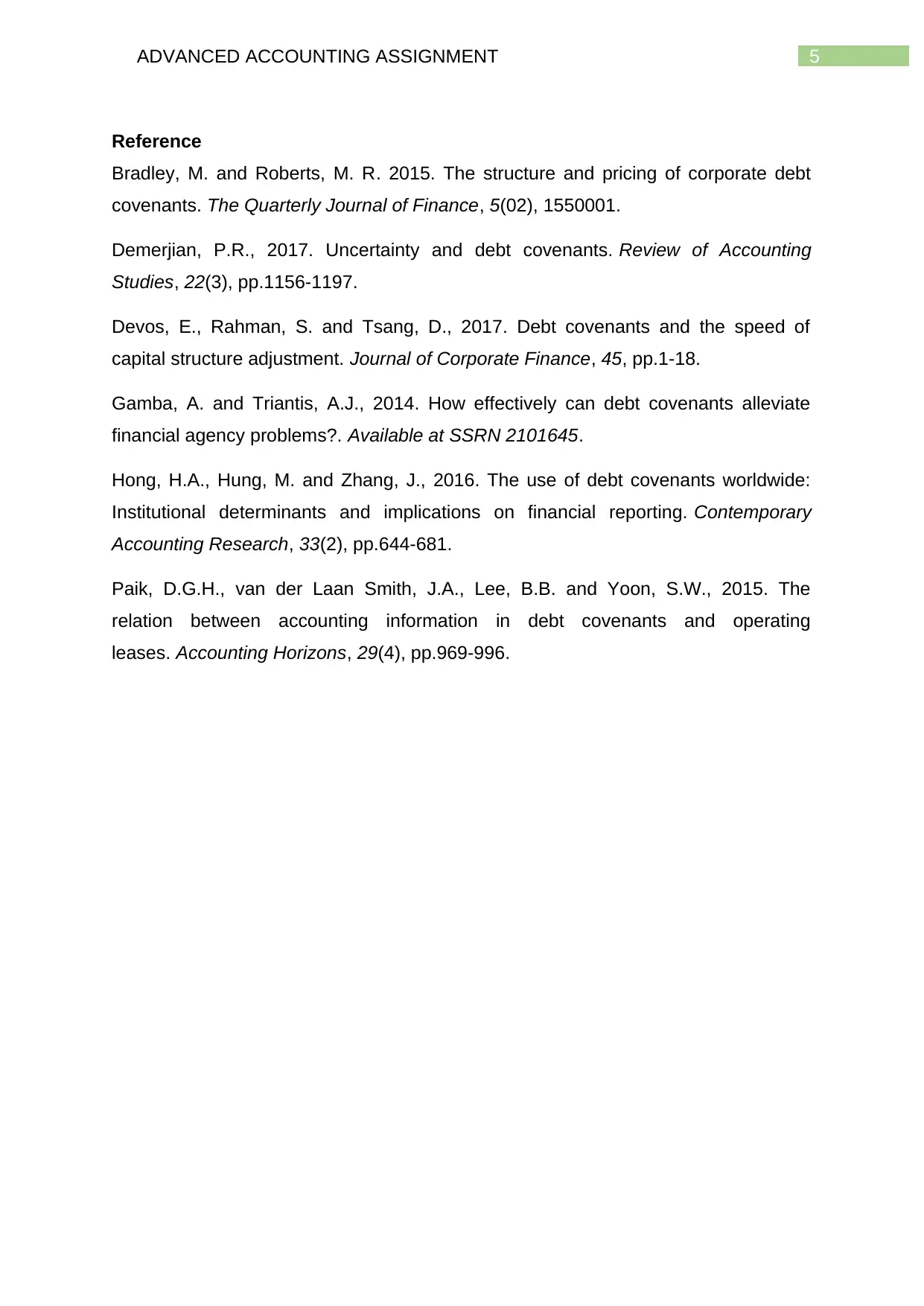
5ADVANCED ACCOUNTING ASSIGNMENT
Reference
Bradley, M. and Roberts, M. R. 2015. The structure and pricing of corporate debt
covenants. The Quarterly Journal of Finance, 5(02), 1550001.
Demerjian, P.R., 2017. Uncertainty and debt covenants. Review of Accounting
Studies, 22(3), pp.1156-1197.
Devos, E., Rahman, S. and Tsang, D., 2017. Debt covenants and the speed of
capital structure adjustment. Journal of Corporate Finance, 45, pp.1-18.
Gamba, A. and Triantis, A.J., 2014. How effectively can debt covenants alleviate
financial agency problems?. Available at SSRN 2101645.
Hong, H.A., Hung, M. and Zhang, J., 2016. The use of debt covenants worldwide:
Institutional determinants and implications on financial reporting. Contemporary
Accounting Research, 33(2), pp.644-681.
Paik, D.G.H., van der Laan Smith, J.A., Lee, B.B. and Yoon, S.W., 2015. The
relation between accounting information in debt covenants and operating
leases. Accounting Horizons, 29(4), pp.969-996.
Reference
Bradley, M. and Roberts, M. R. 2015. The structure and pricing of corporate debt
covenants. The Quarterly Journal of Finance, 5(02), 1550001.
Demerjian, P.R., 2017. Uncertainty and debt covenants. Review of Accounting
Studies, 22(3), pp.1156-1197.
Devos, E., Rahman, S. and Tsang, D., 2017. Debt covenants and the speed of
capital structure adjustment. Journal of Corporate Finance, 45, pp.1-18.
Gamba, A. and Triantis, A.J., 2014. How effectively can debt covenants alleviate
financial agency problems?. Available at SSRN 2101645.
Hong, H.A., Hung, M. and Zhang, J., 2016. The use of debt covenants worldwide:
Institutional determinants and implications on financial reporting. Contemporary
Accounting Research, 33(2), pp.644-681.
Paik, D.G.H., van der Laan Smith, J.A., Lee, B.B. and Yoon, S.W., 2015. The
relation between accounting information in debt covenants and operating
leases. Accounting Horizons, 29(4), pp.969-996.
⊘ This is a preview!⊘
Do you want full access?
Subscribe today to unlock all pages.

Trusted by 1+ million students worldwide
1 out of 6
Related Documents
Your All-in-One AI-Powered Toolkit for Academic Success.
+13062052269
info@desklib.com
Available 24*7 on WhatsApp / Email
![[object Object]](/_next/static/media/star-bottom.7253800d.svg)
Unlock your academic potential
Copyright © 2020–2025 A2Z Services. All Rights Reserved. Developed and managed by ZUCOL.





